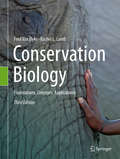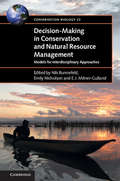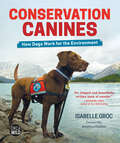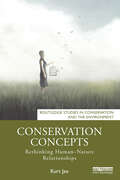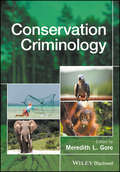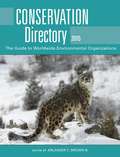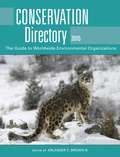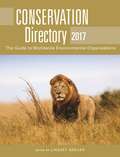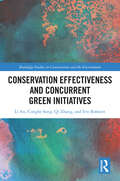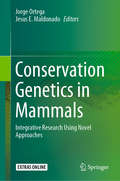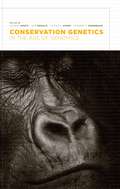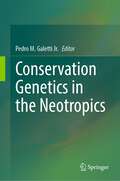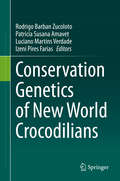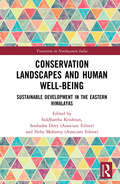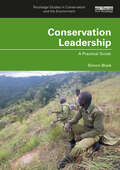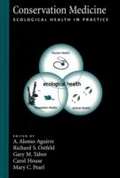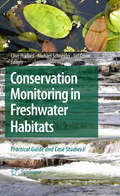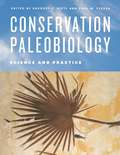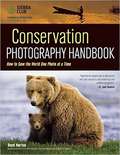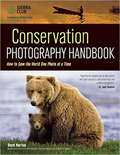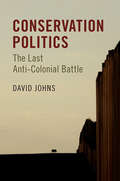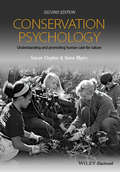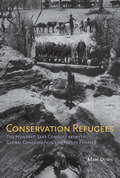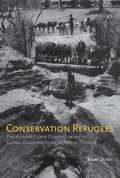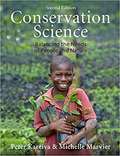- Table View
- List View
Conservation Biology: Foundations, Concepts, Applications
by Rachel L. Lamb Fred Van DykeThis book provides a thorough, up-to-date examination of conservation biology and the many supporting disciplines that comprise conservation science. In this, the Third Edition of the highly successful Conservation Biology: Foundations, Concepts, Applications, the authors address their interdisciplinary topic as it must now be practiced and perceived in the modern world. Beginning with a concise review of the history of conservation, the authors go on to explore the interplay of conservation with genetics, demography, habitat and landscape, aquatic environments, and ecosystem management, and the relationship of all these disciplines to ethics, economics, law, and policy. An entirely new chapter, The Anthropocene: Conservation in a Human-Dominated Nature, breaks new ground in its exploration of how conservation can be practiced in anthropogenic biomes, novel ecosystems, and urban habitats. The Third Edition includes the popular Points of Engagement discussion questions used in earlier editions, and adds a new feature: Information Boxes, which briefly recap specific case histories described in the text. A concluding chapter offers insight into how to become a conservation professional, in both traditional and non-traditional roles.The authors, Fred Van Dyke and Rachel Lamb, draw on their expertise as field biologists, wildlife managers, consultants to government and industry, and scholars of environmental law, policy, and advocacy, as well as their many years of effective teaching experience. Informed by practical knowledge and acquired skills, the authors have created a work of exceptional clarity and readability which encompasses both systemic foundations as well as contemporary developments in the field. Conservation Biology: Foundations, Concepts, Applications will be of invaluable benefit to undergraduate and graduate students, as well as to working conservation scientists and managers.This is an amazing resource for students, faculty, and practitioners both new and experienced to the field. Diane Debinski, PhD Unexcelled wisdom for living at home on Wonderland Earth, the planet with promise, destined for abundant life. Holmes Rolston, PhDVan Dyke and Lamb have maintained the original text’s emphasis on connecting classical ecological and environmental work with updated modern applications and lucid examples. But more importantly, the third edition contains much new material on the human side of conservation, including expanded treatments of policy, economics, and climate change. Tim Van Deelen, PhD Fred Van Dyke and Rachel Lamb break new ground in both the breadth and depth of their review and analysis of this crucially important and rapidly changing field. Any student or other reader wishing to have a comprehensive overview and understanding of the complexities of conservation biology need look no further – this book is your starting point! Simon N. Stuart, PhDAnyone who teaches, talks or writes and works on Conservation Biology, needs this latest edition of Conservation Biology (Foundations, Concepts, Applications, 3rd edition) by Fred Van Dyke and Rachel L. Lamb. This will be useful to both beginners and experts as well. The authors included almost all important issues in relation to conservation biology. This is really an outstanding book. Bidhan Chandra Das, Professor, Ecology Branch, Department of Zoology, University of Rajshahi, Bangladesh
Conservation Biology: Models for Interdisciplinary Approaches (Conservation Biology #22)
by E. J. Nils Bunnefeld Emily Nicholson Milner-GullandMaking decisions about the management and conservation of nature is necessarily complex, with many competing pressures on natural systems, opportunities and benefits for different groups of people and a varying, uncertain social and ecological environment. An approach which is narrowly focused on either human development or environmental protection cannot deliver sustainable solutions. This volume provides frameworks for improving the integration of natural resource management with conservation and supporting stronger collaboration between researchers and practitioners in developed and developing countries. Novel approaches are required when ecological and social dynamics are highly interdependent. A structured, participatory, model-based approach to decision-making for biodiversity conservation has been proven to produce real-world change. There are surprisingly few successful case studies, however; some of the best are presented here, from fisheries, pest management and conservation. Researchers and practitioners need this interdisciplinary approach, focused on quantitative tools that have been tested and applied, and learning from success.
Conservation Canines: How Dogs Work for the Environment (Orca Wild #7)
by Isabelle GrocKey Selling Points The book examines how dogs are chosen and trained for conservation work and details the kind of work they do all over the world, in Africa, Italy, Portugal, France, Australia, Haida Gwaii and the United States. The author is a highly respected photojournalist, filmmaker and the author of Gone is Gone: Wildlife Under Threat and Sea Otters: A Survival Story, which are also part of the Orca Wild series. Isabelle Groc's stunning photos of working dogs give the book a hands-on feel. For fans of the TV show Dogs With Jobs—but for the environment! Includes a foreword by award-winning actor, director, producer and author Anjelica Huston.
Conservation Concepts: Rethinking Human–Nature Relationships (Routledge Studies in Conservation and the Environment)
by Kurt JaxThis book provides a review of the multitude of conservation concepts, both from a scientific, philosophical, and social science perspective, asking how we want to shape our relationships with nature as humans, and providing guidance on which conservation approaches can help us to do this. Nature conservation is a contested terrain and there is not only one idea about what constitutes conservation but many different ones, which sometimes are conflicting. Employing a conceptual and historical analysis, this book sorts and interprets the differing conservation concepts, with a special emphasis on narrative analysis as a means for describing human–nature relationships and for linking conservation science to practice and to society at large. Case studies illustrate the philosophical issues and help to analyse major controversies in conservation biology. While the main focus is on Western ideas of conservation, the book also touches upon non-Western, including indigenous, concepts. The approach taken in this book emphasises the often implicit strategic and societal dimensions of conservation concepts, including power relations. In finding a path through the multitude of concepts, the book showcases that it is necessary to maintain the plurality of approaches, in order to successfully address different situations and societal choices. Overall, this book highlights the very tension which conservation biology must withstand between science and society: between what is possible and what we want individually or as a society or even more what is desirable. Bringing some order into this multitude will support more efficient conservation and conservation biology. This book will be of great interest to students and scholars studying nature conservation from a variety of disciplines, including biology, ecology, anthropology, sociology, geography, and philosophy. It will also be of use to professionals wanting to gain an understanding of the broad spectrum of conservation concepts and approaches and when to apply them.
Conservation Criminology
by Meredith L. GoreThis important new text introduces conservation criminology as the interdisciplinary study of environmental exploitation and risks at the intersection of human and natural systems. Taking an interdisciplinary approach, the book enhances understanding of the various human and organizational behaviors that pose risks to the environment, humans, and drive conservation crime. As human population growth, global market economies, climate change, deforestation, and illegal exploitation of natural resources continue to increase, academic research from numerous disciplines is needed to address these challenges. Conservation Criminology promotes thinking about how unsustainable natural resources exploitation is a cause and a consequence of social conflict. Case studies profiled in the book demonstrate this cause and effect type situation, as well as innovative approaches for reducing risks to people and the environment. This text encourages readers to consider how humans behave in response to environmental risks and the various mechanisms that constitute effective and ineffective approaches to enforcement of wildlife crimes, including environmental and conservation policy. Case studies from the USA, Latin America, Africa, and Asia highlight corruption in conservation, global trade in electronic waste, illegal fishing, illegal logging, human-wildlife conflict, technology and space, water insecurity, wildlife disease, and wildlife poaching. Taken together, chapters expand the reader’s perspective and employ tools to understand and address environmental crimes and risks, and to provide novel empirical evidence for positive change. With established contributors providing interdisciplinary and global perspectives, this book establishes a foundation for the emerging field of conservation criminology.
Conservation Directory 2015
by FederationThe 2015 edition of National Wildlife Federation's Conservation Directory is the most comprehensive listing of conservation and environmental organizations yet published, with information on more than 4,000 government agencies, nongovernmental organizations, and colleges and universities, as well as more than 18,000 officials concerned with environmental conservation, education, and natural resource use and management.Each entry contains detailed contact information, including names, addresses, and telephone numbers. Also included are selected email and Internet addresses, descriptions of program areas, senior staff by name and responsibility, principal publications, and more. Entries are categorized by organization and state or country and are indexed alphabetically and by subject on topics ranging from acid rain to zoology. Each person listed in the directory is also indexed alphabetically
Conservation Directory 2015: The Guide to Worldwide Environmental Organizations
by Arlander C. BrownThe authority on natural resource use and management agencies around the world.Do you want to take action to protect Earth’s environment? Are you interested in learning more about wildlife conservation and environmental groups? The Conservation Directory 2015 is a great resource for budding environmental activists and scholars alike who want to achieve a peaceful, equitable, and sustainable future. This all-inclusive volume is an amazing resource that can help further these environmental goals.The new and revised 2015 edition of the Conservation Directory is the most comprehensive listing of conservation and environmental organizations yet published, with information on more than four thousand government agencies, nongovernmental organizations, and colleges and universities, as well as more than eighteen thousand officials concerned with environmental conservation, education, and natural resource use and management.Each entry contains detailed contact information, including names, addresses, and telephone numbers. Also included are selected email and Internet addresses, descriptions of program areas, senior staff by name and responsibility, principal publications, and more. Entries are categorized by organization and state or country and are indexed alphabetically and by subject on topics ranging from acid rain to zoology. Each person listed in the directory is also indexed alphabetically.
Conservation Directory 2017: The Guide to Worldwide Environmental Organizations
by Lindsey BreuerDo you want to take action to protect Earth’s environment? Are you interested in learning more about wildlife conservation and environmental groups? The Conservation Directory 2017 is a great resource for budding environmental activists and scholars alike who want to achieve a peaceful, equitable, and sustainable future. This all-inclusive volume is an amazing resource that can help further these environmental goals.The new and revised 2017 edition of the Conservation Directory is the most comprehensive listing of conservation and environmental organizations yet published, with information on more than four thousand government agencies, nongovernmental organizations, and colleges and universities, as well as more than eighteen thousand officials concerned with environmental conservation, education, and natural resource use and management.Each entry contains detailed contact information, including names, addresses, and telephone numbers. Also included are selected email and Internet addresses, descriptions of program areas, senior staff by name and responsibility, principal publications, and more. Entries are categorized by organization and state or country and are indexed alphabetically and by subject on topics ranging from acid rain to zoology. Each person listed in the directory is also indexed alphabetically.
Conservation Effectiveness and Concurrent Green Initiatives (Routledge Studies in Conservation and the Environment)
by Qi Zhang Li An Conghe Song Eve BohnettThe book examines concurrent green initiatives and their spillover effects on environmental conservation and management to reveal their impact on conservation effectiveness, drawing on a range of international case studies. Green initiatives are programs, payments, or endeavors that restore, sustain, or improve nature’s capacity, with examples including payments for ecosystem services and the development of nature reserves and protected areas. This book explicitly examines concurrent green initiatives, where initiatives overlap either geographically or in terms of recipients of multiple payments. The book provides a detailed analysis of case studies in the USA and China, including the USA-based Conservation Reserve Program and the Environmental Quality Incentives Program, and the China based Grain-to-Green Program and the Forest Ecological Benefit Compensation Fund. Through this comparison, the book shows the impact of concurrent green initiatives, including additional or unintended benefits for conservation and local communities as well as negative spillover effects. The book complements these case studies by drawing on other global examples ranging in size from local to continental, including planting native trees and shrubs in Australia and green initiatives in the Baltic Sea region. Overall, this book demonstrates the importance of analyzing concurrent green efforts to better understand both the positive and negative impacts to ensure the optimal effectiveness of these policies and programs for conservation and environmental management. This book will be of great interest to students and scholars of environmental conservation and management, land use, ecosystem services and environmental policy, as well as policymakers and practitioners working on environmental initiatives and programs.
Conservation Genetics in Mammals: Integrative Research Using Novel Approaches
by Jorge Ortega Jesus E. MaldonadoThis book focuses on the use of molecular tools to study small populations of rare and endangered mammals, and presents case studies that apply an evolutionary framework to address innovative questions in the emerging field of mammalian conservation genomics using a highly diverse set of novel molecular tools. Novel and more precise molecular technologies now allow experts in the field of mammology to interpret data in a more contextual and empirical fashion and to better describe the evolutionary and ecological processes that are responsible for the patterns they observe. The book also demonstrates how recent advances in genetic/genomic technologies have been applied to assess the impact of environmental/anthropogenic changes on the health of small populations of mammals. It examines a range of issues in the field of mammalian conservation genomics, such as the role that the genetic diversity of the immune system plays in disease protection and local adaptation; the use of noninvasive techniques and genomic banks as a resource for monitoring and restoring populations; the structuring of population by physical barriers; and genetic diversity. Further, by integrating research from a variety of areas – including population genetics, molecular ecology, systematics, and evolutionary and conservation biology – it enables readers to gain a deeper understanding of the conservation biology of mammals that are at increasing risk of extinction at local, regional and global scales. As such, it offers a unique resource for a broad readership interested in the conservation biology of mammals and conservation management strategies to better preserve biodiversity.
Conservation Genetics in the Age of Genomics (American Museum of Natural History, Center for Biodiversity Conservation, Series on Biodiversity)
by George Oliver A. Ryder Howard C. Rosenbaum Rob DeSalle Eds. AmatoGenome sequencing enables scientists to study genes over time and to test the genetic variability of any form of life, from bacteria to mammals. Thanks to advances in molecular genetics, scientists can now determine an animal's degree of inbreeding or compare genetic variation of a captive species to wild or natural populations. Mapping an organism's genetic makeup recasts such terms as biodiversity and species and enables the conservation of rare or threatened species, populations, and genes. By introducing a new paradigm for studying and preserving life at a variety of levels, genomics offers solutions to previously intractable problems in understanding the biology of complex organisms and creates new tools for preserving the patterns and processes of life on this planet. Featuring a number of high-profile researchers, this volume introduces the use of molecular genetics in conservation biology and provides a historical perspective on the opportunities and challenges presented by new technologies. It discusses zoo-, museum-, and herbarium-based biological collections, which have expanded over the past decade, and covers the promises and problems of genomic and reproductive technology. The collection concludes with the philosophical and legal issues of conservation genetics and their potential effects on public policy.
Conservation Genetics in the Neotropics
by Pedro M. GalettiThis book explores how genetics and the new technologies in genomics have been used for conservation of plants and animals in the Neotropics. It shows the new perspective for conservation genetics beyond the use of theoretical and methods in genetics at species level and presents how genetics and genomics can be used for assessing communities. Conservation genetics and genomics are presented as a helpful field of study for resolving taxonomic uncertainties and hidden biodiversity, understanding populations and extinction risk, genetic management, wildlife forensic genetics, assessing biology and molecular ecology, assessing communities, conservation genomics and the use of conservation biology and genetics in science learning, highlighting case studies in the Neotropics. Applications of conservation genetics for management or policy, decision making, planning, and implementation of conservation practice in the Neotropics are addressed across chapters. This book will interest to researchers and students in conservation genetics and biology conservation interested in the Neotropics. Stakeholders and decision makers in conservation biology may also find this book useful.
Conservation Genetics of New World Crocodilians
by Rodrigo Barban Zucoloto Patricia Susana Amavet Luciano Martins Verdade Izeni Pires FariasThis book aims to be a comprehensive review of the literature on the conservation genetics of the New World crocodilians, from the biological and demographical aspects of the living species to the application of molecular techniques for conservation purposes. It covers the current status of the molecular genetics applied to phylogenetics, phylogeography, diversity, kinship and mating system, and hybridization, as well its implications for decision making with regards to the conservation of these species at academic and governmental levels. This book can be used as a guide for graduate and undergraduate students to understand how conservation genetics techniques are carried out and how they can help preserve not only crocodilians but also other living species.
Conservation Landscapes and Human Well-Being: Sustainable Development in the Eastern Himalayas (Transition in Northeastern India)
by Siddhartha KrishnanThe Himalayas are said to be the youngest mountain ranges in the world. This book studies the well-being of the eastern Himalayan forest-dwellers in terms of their capabilities and functioning. Using Amartya Sen’s and Martha Nussbaum’s Capabilities Approach, it examines the educational and health opportunities and substantial freedoms afforded to farmers and pastoralists living and working in the Senchal and Singalila Protected Areas of North Bengal, India. It also discusses the challenges and potential of the Forest Rights Act as a well-being delivery mechanism. The book adopts a comparative narrative of socio-ecological information generated from interviews, ecological field methods, remote sensing and participatory rural appraisals to provide insight on human development in conservation contexts. This volume will be of interest to students and researchers of conservation biology, development studies, socio-ecological systems studies, political ecology, human development index, ecological economics, environmental sociology, and South Asian studies. It will also be useful to policy-makers and NGOs in the conservation and livelihoods sector.
Conservation Leadership: A Practical Guide (Routledge Studies in Conservation and the Environment)
by Simon BlackThis book is an important guide for individuals seeking to develop and grow their leadership skills in the wildlife conservation sector, across varied disciplines such as environmental management, conservation biology, and ecotourism.Conservation Leadership addresses what leadership is, why it is important, and how to be an effective leader. It identifies the common pitfalls or mistakes in a leader’s thinking or behaviour, and the unexpected consequences or responses which can arise, and then explores more helpful alternative approaches to leadership. The book is divided into three parts: Part I: Leadership principles Part II: Four areas of profound theory: knowledge, psychology, systems, and variation Part III: Skills and competencies for conservation leaders It focuses on contextual and organisational challenges in conservation, including limited resources, remote locations, fragile species of concern, politics, community conflict, crime, and commercial pressures. The scope is global, using diverse examples such as sea turtle head-starting in South Asia, reforestation in North Africa, bird conservation in North America, human–wildlife interactions in the Himalayas, and post-colonial issues in the Caribbean. Case studies illustrate key learning points from small local teams through to global transnational initiatives. Exercises in each chapter enable the exploration of less-familiar topics, including interpersonal skills, goal setting and performance measurement, plus a unique research-derived conservation leadership self-assessment tool.This book is an essential reading resource for professionals and senior leaders in the wildlife management and conservation sector, as well as students on biodiversity conservation, wildlife conservation, and environmental management courses.
Conservation Medicine: Ecological Health in Practice
by Carol House Richard Ostfeld Gary Tabor Mary Pearl A. AguirreConservation medicine is an emerging discipline, focussing on the intersection of ecosystem health, animal health, and human health. Work in the biomedical and veterinary sciences is now being folded into conservation biology; to explore the connections between animal and human health; trace the environmental sources of pathogens and pollutants; develop an understanding of the ecological causes of changes in human and animal health; and understand the consequences of diseases to populations and ecological communities.Conservation Medicinedefines this new discipline. It examines ecological health issues from various standpoints, including the emergence and resurgence of infectious disease agents; the increasing impacts of toxic chemicals and hazardous substances; and the health implications of habitat fragmentation and degradation and loss of biodiversity. It will provide a framework to examine the connections between the health of the planet and the health of all species and challenge practitioners and students in the health sciences and natural sciences to think about new, collaborative ways to address ecological health concerns.
Conservation Monitoring in Freshwater Habitats: A Practical Guide and Case Studies
by Michael Schneider Clive Hurford Ian CowxThe predicted changes to global weather patterns and increases in the human population will put unprecedented pressure on European freshwater habitats and the species that depend on them. Our success in conserving the ecological value of these habitats will depend greatly on carefully planned conservation management integrated with efficient and reliable monitoring. "Conservation Monitoring in Freshwater Habitats" focuses on the need to develop clear, site-specific, conservation management goals; something rarely considered in previous publications on freshwater monitoring. The early chapters explore the use of biological indicators for monitoring and provide practical guidance for developing and implementing efficient and reliable monitoring projects. The remainder of the book is dedicated to a series of carefully selected case studies illustrating best practice in both decision-making and application across a range of habitats and species. This timely book will provide a valuable reference for students and researchers in biological and environmental sciences, and for practitioners working in government departments, conservation organizations and ecological consultancies. It will be an essential resource for anyone working towards fulfilling the requirements of both the Water Framework Directive and the EC Habitats Directive.
Conservation Paleobiology: Science and Practice
by Gregory P. Dietl Karl W. FlessaIn conservation, perhaps no better example exists of the past informing the present than the return of the California condor to the Vermilion Cliffs of Arizona. Extinct in the region for nearly one hundred years, condors were successfully reintroduced starting in the 1990s in an effort informed by the fossil record—condor skeletal remains had been found in the area’s late-Pleistocene cave deposits. The potential benefits of applying such data to conservation initiatives are unquestionably great, yet integrating the relevant disciplines has proven challenging. Conservation Paleobiology gathers a remarkable array of scientists—from Jeremy B. C. Jackson to Geerat J. Vermeij—to provide an authoritative overview of how paleobiology can inform both the management of threatened species and larger conservation decisions. Studying endangered species is difficult. They are by definition rare, some exist only in captivity, and for those still in their native habitats any experimentation can potentially have a negative effect on survival. Moreover, a lack of long-term data makes it challenging to anticipate biotic responses to environmental conditions that are outside of our immediate experience. But in the fossil and prefossil records—from natural accumulations such as reefs, shell beds, and caves to human-made deposits like kitchen middens and archaeological sites—enlightening parallels to the Anthropocene can be found that might serve as a primer for present-day predicaments. Offering both deep-time and near-time perspectives and exploring a range of ecological and evolutionary dynamics and taxa from terrestrial as well as aquatic habitats, Conservation Paleobiology is a sterling demonstration of how the past can be used to manage for the future, giving new hope for the creation and implementation of successful conservation programs.
Conservation Photography Handbook: How To Save The World One Photo At A Time
by Boyd NortonThis book is a call to action, providing the tools photographers need to help preserve threatened species and environments around the world or in their own backyards. Author/photographer Boyd Norton has spent over four decades successfully doing just that, and is credited with saving millions of wilderness acres through his photographs and personal activism. In this book, Norton shares his approaches to designing powerful images that communicate the threats facing wilderness areas, wildlife, and people around the world. His expert advice guides you step by step through the process of capturing effective photographs and implementing them to educate and build support for these critically important issues. Also featured are images and techniques from acclaimed conservation photographers Amy Gulick, Alexandra Garcia, Alison M. Jones, Joe Riis, Bob Rozinski, and Wendy Shattil.
Conservation Photography Handbook: How To Save The World One Photo At A Time
by Boyd NortonThis book is a call to action, providing the tools photographers need to help preserve threatened species and environments around the world or in their own backyards. Author/photographer Boyd Norton has spent over four decades successfully doing just that, and is credited with saving millions of wilderness acres through his photographs and personal activism. In this book, Norton shares his approaches to designing powerful images that communicate the threats facing wilderness areas, wildlife, and people around the world. His expert advice guides you step by step through the process of capturing effective photographs and implementing them to educate and build support for these critically important issues. Also featured are images and techniques from acclaimed conservation photographers Amy Gulick, Alexandra Garcia, Alison M. Jones, Joe Riis, Bob Rozinski, and Wendy Shattil.
Conservation Politics: The Last Anti-Colonial Battle
by David JohnsWhilst the science of conservation biology is thriving as a discipline, ultimately global conservation is failing. Why, when the majority of people say they value nature and its protection? David Johns argues that the loss of species and healthy ecosystems is best understood as human imposition of a colonial relationship on the non-human world - one of exploitation and domination. Global institutions benefit from transforming nature into commodities, and conservation is a low priority. This book places political issues at the forefront, and tackles critical questions of conservation efficacy. It considers the role of effective influence on decision making, key policy changes to reduce human footprint, and the centrality of culture in mobilising support. It draws on political lessons from successful social movements, including human anti-colonial struggles, to provide conservation biologists and practitioners in scientific and social science disciplines and NGOs with the tools and wider context to accelerate their work's impact.
Conservation Psychology
by Susan Clayton Gene MyersThis textbook introduces the reader to the new and emerging field of Conservation Psychology, which explores connections between the study of human behavior and the achievement of conservation goals.People are often cast as villains in the story of environmental degradation, seen primarily as a threat to healthy ecosystems and an obstacle to conservation. But humans are inseparable from natural ecosystems. Understanding how people think about, experience, and interact with nature is crucial for promoting environmental sustainability as well as human well-being.The book first summarizes theory and research on human cognitive, emotional, and behavioral responses to nature and goes on to review research on people's experience of nature in wild, managed, and urban settings. Finally, it examines ways to encourage conservation-oriented behavior at both individual and societal levels. Throughout, the authors integrate a wide body of published literature to demonstrate how and why psychology is relevant to promoting a more sustainable relationship between humans and nature.
Conservation Refugees: The Hundred-Year Conflict between Global Conservation and Native Peoples (The\mit Press Ser.)
by Mark DowieHow native people—from the Miwoks of Yosemite to the Maasai of eastern Africa—have been displaced from their lands in the name of conservation.Since 1900, more than 108,000 officially protected conservation areas have been established worldwide, largely at the urging of five international conservation organizations. About half of these areas were occupied or regularly used by indigenous peoples. Millions who had been living sustainably on their land for generations were displaced in the interests of conservation. In Conservation Refugees, Mark Dowie tells this story. This is a “good guy vs. good guy” story, Dowie writes; the indigenous peoples' movement and conservation organizations have a vital common goal—to protect biological diversity—and could work effectively and powerfully together to protect the planet and preserve biological diversity. Yet for more than a hundred years, these two forces have been at odds. The result: thousands of unmanageable protected areas and native peoples reduced to poaching and trespassing on their ancestral lands or “assimilated” but permanently indentured on the lowest rungs of the money economy. Dowie begins with the story of Yosemite National Park, which by the turn of the twentieth century established a template for bitter encounters between native peoples and conservation. He then describes the experiences of other groups, ranging from the Ogiek and Maasai of eastern Africa and the Pygmies of Central Africa to the Karen of Thailand and the Adevasis of India. He also discusses such issues as differing definitions of “nature” and “wilderness,” the influence of the “BINGOs” (Big International NGOs, including the Worldwide Fund for Nature, Conservation International, and The Nature Conservancy), the need for Western scientists to respect and honor traditional lifeways, and the need for native peoples to blend their traditional knowledge with the knowledge of modern ecology. When conservationists and native peoples acknowledge the interdependence of biodiversity conservation and cultural survival, Dowie writes, they can together create a new and much more effective paradigm for conservation.
Conservation Refugees: The Hundred-year Conflict Between Global Conservation And Native Peoples
by Mark DowieSince 1900, more than 108,000 officially protected conservation areas have been established worldwide, largely at the urging of five international conservation organizations. About half of these areas were occupied or regularly used by indigenous peoples. Millions who had been living sustainably on their land for generations were displaced in the interests of conservation. In Conservation Refugees, Mark Dowie tells this story. This is a "good guy vs. good guy" story, Dowie writes; the indigenous peoples' movement and conservation organizations have a vital common goal--to protect biological diversity--and could work effectively and powerfully together to protect the planet and preserve biological diversity. Yet for more than a hundred years, these two forces have been at odds. The result: thousands of unmanageable protected areas and native peoples reduced to poaching and trespassing on their ancestral lands or "assimilated" but permanently indentured on the lowest rungs of the money economy. Dowie begins with the story of Yosemite National Park, which by the turn of the twentieth century established a template for bitter encounters between native peoples and conservation. He then describes the experiences of other groups, ranging from the Ogiek and Maasai of eastern Africa and the Pygmies of Central Africa to the Karen of Thailand and the Adevasis of India. He also discusses such issues as differing definitions of "nature" and "wilderness," the influence of the "BINGOs" (Big International NGOs, including the Worldwide Fund for Nature, Conservation International, and The Nature Conservancy), the need for Western scientists to respect and honor traditional lifeways, and the need for native peoples to blend their traditional knowledge with the knowledge of modern ecology. When conservationists and native peoples acknowledge the interdependence of biodiversity conservation and cultural survival, Dowie writes, they can together create a new and much more effective paradigm for conservation.
Conservation Science: Balancing the Needs of People and Nature
by Peter Kareiva Michelle MarvierNow is the time for conservation science―a mission-oriented scientific enterprise that seeks to protect nature, including Earth’s animals, plants, and ecosystems, in the face of unprecedented human demands upon the planet. Conservation scientists apply principles from ecology, population genetics, economics, political science, and other natural and social sciences to manage and preserve nature. The focus of this textbook is first and foremost on protecting nature and especially Earth’s biota. It also contains a heavy emphasis on highlighting strategies to better connect the practice of conservation with the needs and priorities of a growing human population. <p><p> Now used at over 150 colleges and universities, Conservation Science is an original and modern approach to conservation. Gretchen Daily (Stanford University) says it well: “Based on unparalleled, firsthand experience, Kareiva and Marvier explore the innovative approaches to conservation being honed around the world today. Their account is rigorous and engaging, with fresh questions, data, and quantitative analysis interwoven with vivid stories of actual conservation practice in the field." <p><p> Conservation Science was primarily written primarily for undergraduates and beginning graduate students who are interested either in academic careers or working in conservation at government agencies, non-governmental organizations, or international institutions.
